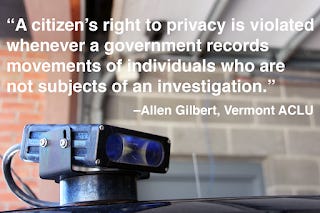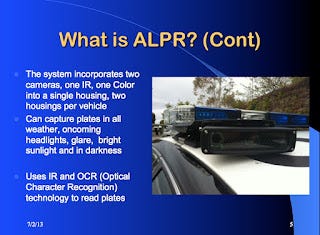License plate readers spy on passengers and your social media activity (Updated)

image credit: digital vpr
Police and DHS are using 3M's Mobile Automatic License Plate Reader (ALPR) camera system to create a nationwide surveillance network. Fyi, automatic number plate recognition was invented in 1976 in the UK.
DHS/Police use ALPR's to create a nationwide 'hotlist'
According to a Security Info Watch article, P.J. Hardy, a Lebanon police public information officer said the system [ALPR] works in conjunction with DHS and the sexual offender database. Click here & here to find out more.
"Anytime there is an alert from where something has been entered from anywhere across the U.S with that combination of letters and numbers, it'll send an alert to wherever we want that to go. In our case it'll go to our dispatch center," he said.
According to a DHS 'Acquisition and use of License Plate Data' report. DHS uses ALPR's to identify, arrest, and remove aliens who are immigration enforcement priorities, fugitive aliens, illegal re-entrants, and those individuals posing a public safety or national security risk.
To find out more about 'hotlists' read my article, Police use 'Pay-By-Plate' to "hotlist" motorists across the country.
Update 10/18:
DEA uses license plate readers to spy on gun show attendees
“The DEA Phoenix Division Office is working closely with ATF on attacking the guns going to [redacted] and the gun shows, to include programs/operation with LPRs at the gun shows.” The government redacted the rest of the email, but when we [ACLU] received this document we concluded that these agencies used license plate readers to collect information about law-abiding citizens attending gun shows.
DEA claims it was a only a proposal, ACLU doubts DEA's claims:
"if the program was cancelled, why didn’t we get any documents reflecting that decision in response to our FOIA request?"
DHS admits ALPR's spy on our private lives
DHS acknowledges ALPR's are spying on us. The excerpts listed below, were taken from page 4 of DHS's Acquisition of ALPR's report. LPR data in the aggregate may detail an individual’s travel over time, leading to concerns about unwarranted surveillance. LPR data in the aggregate may provide details about an individual’s private life, such as frequenting a place of worship or participating in protests and meetings, thereby implicating constitutionally-protected freedoms.
LPR data may be inappropriately shared with other agencies or private entities.
3M admits ALPR's are used for data mining
Perhaps the most powerful application is its data mining capability, allowing users to locate and map hits based on a wide range of criteria including partial plates, street address, GPS coordinates, and time and date.
Police use ALPR's to identify passengers
According to the Maryland Coordination and Analysis Center or Fusion Center, ALPR's are being used to identify passengers.
The digital image can include additional information such as:
If a given plate is listed in the database, the system is capable of providing the vehicle's location, direction of travel, and the type of infraction related to the notification.
Earlier this year, I warned everyone, that police use secret facial biometric cameras to identify motorists, passengers.
Three years ago the Virginia Dept. of Motor Vehicles allowed the Insurance Institute for Highway Safety to secretly record the vehicle identification number, age and sex information from the records of 65,000 vehicle owners and compare them to speed camera images.
Though primarily intended for fixed security camera installations, the software could allow police to identify the occupants of vehicles when the system is supplied with a clear photograph of a car's interior. In states such as California and Arizona where red light cameras and speed cameras photograph the front of a car, the video stream can be analyzed in "near real time" to catalog and identify the driver and anyone in the passenger seat of passing vehicles, flagging "any person of interest."
Real-time face recognition lets police continuously scan the faces of pedestrians walking by a street surveillance camera. It may seem like science fiction. It is real. Contract documents and agency statements show that at least five major police departments—including agencies in Chicago, Dallas, and Los Angeles—either claimed to run real-time face recognition off of street cameras, bought technology that can do so, or expressed a written interest in buying it. Nearly all major face recognition companies offer real-time software.
ALPR's alert police to your social media activity

image credit: Eastbay Express
According to Maryland's Analysis Center, ALPR's alert police to your social media activity.
Non-Criminal Intelligence Files: Data, frequently raw and unanalyzed, compiled by law enforcement agencies in the conduct of normal business, such as suspicious activity tips, numbers and types of calls received from the public in agency call centers, situational awareness/officer safety information, etc. These files may also include open source (i.e. news media and publically accessible internet) information.
Police also use MediaSonar, X1 Social Discovery and Geofeedia to spy on our social media activity. Click here, here & here to find out more.

image credit: ArsTechnica
3M's cameras feature unique technologies to enhance read accuracy by suppressing ambient light such as headlights and bright sunlight. Samsung's Wisenet III cameras, can identify people through fog. How much would you like to bet 3M's cameras can do the same? Click here to find out more about 3M's ALPR technology.

image credit:Slideshare
On page 14, of the International Association of Chiefs of Police policy for ALPR's, under the subject 'Matching Performance' they admit 'hotlists' are inaccurate.
In other words, ALPR's should assign 'hotlisted' vehicles a probability [accuracy] score.
This should serve as a wake up call to everyone. The Feds are using ALPR's to create a nationwide database on drivers and passengers.


